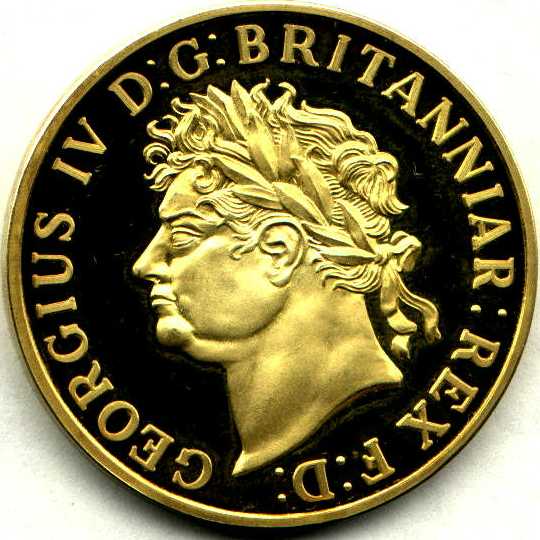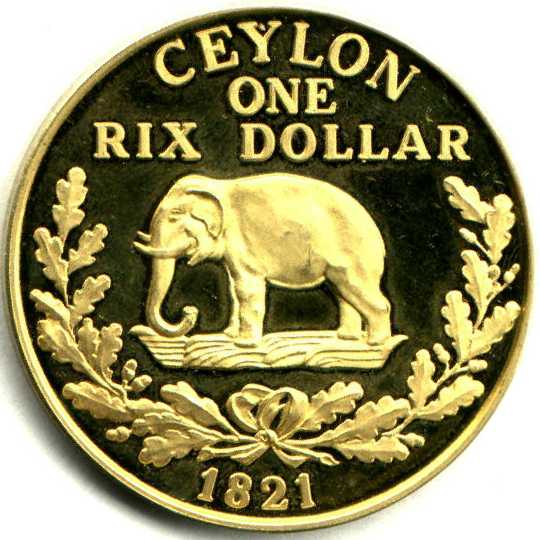| SPECIFICATIONS | |
| Denomination | one RixDollar |
| Alloy | Silver.925 |
| Diameter | 45.0 mm |
| Thickness | 3.0 mm |
| Weight | 37.3 gms |
| Shape | Round |
| Edge | Plain |
| DieAxis | 0° |
| Mintage | 5,000 |



|

|

| ||||||||||||||||||||

| ||||||||||||||||||||||
Obverse : Within plain rim, Laureate head to left,
In margin GEORGIUS IV D:G:BRITANNIAR:REX F:D:
Reverse : Within plain rim, elephant on ground to left within wreath;
above, in three lines CEYLON ONE RIX DOLLAR and below
1821
Edge : Plain with incuse Hallmark ET+ STG OE .
The O has a crab-like symbol within it and will hopefully
identifies the Mint and date.
I guess ET+ is for electro-plate and STG for Sterling. The size and weight is consistent with it being Sterling Silver. The Proof-like has toned on obverse along the periphery.
Over a year later after much discussion the item was traced to be one of a set of 30 Gold Plated Sterling Silver medallions Our Cape Coin Heritage 1600 - 1834 issued by the Africana Commemorative Mint in 1978 in a lockable wooden display case with a blue & white porcelain tile on top. The 6x5 array of same size medallions are embedded on red velvet with a bronze center column engraved with names of the five subsets. Two hard-cover booklets giving the history of each coin fit into a pocket in lid. The issue price per medal was 29 SA-Rand (US$33.33 in 1978).
I find it amazing that so little was known about this set of which 5000 were minted and issued in 1978. Each medal contains 1.1 Troy ounces of pure Silver. Maybe many got melted when the value of Silver peaked in 1980 at bit over $50 per troy ounce.
According to Prof. Michael T. W. Arnheim, head of the
Dept. of Classics, University of Witwatersrand, Johanesburgh, South
Africa, who wrote the introductory book to the collection says
The Cape has always been very much a tavern of the seas, and we
ought not therefore be particularly surprised to find the coins of all
major European trading powers circulating there. ... Ceylon Coinage
circulated widely along the eastern trade routes and not least in the
Cape. The unit of currency remained the Rix Dollars, a survival from
Ceylon's Dutch Period
The Rix dollar introduced at Cape Town, by the Dutch East India Company, was initially a silver coin and later (1781) a paper note. When The British occupied the Cape for the second time in 1806 the acting Governor, Major General Baird, immediately issued a proclamation to establish the relative values of all coins in circulation in the Cape. The Rix-dollar(Rd) was two English shillings. On 1825 June 6th, Sir Charles Somerset issued a proclamation that only British Sterling would be legal tender in the Cape. Despite this, the Rix Dollar was still used for many years in the Cape, changing to the sterling system exclusively only by 1868.
The Medallion was scanned at 300 dpi and displayed at 125 dpi with the Hallmark on edge at 600 dpi. It was won in 2002 February on eBay from a seller in Bangkok, Thailand. It was encased in protective Plastic capsule.
I thank Craig Bowles and Nigel Morton of of South Africa for sending me images with the detailed information about this set of medallion coins in 2003 August.